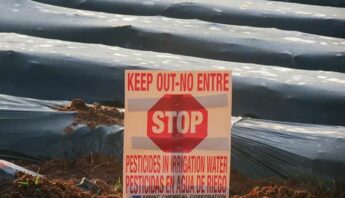For immediate release January 14, 2015
Contact:
Paul Towers, PAN, 916-216-1082
Anne Katten, CRLAF, 916-204-2876
DPR Recommendations Leave California Schoolchildren, Rural Communities at Risk from Cancer-Causing Pesticide
DPR “recommendations” would allow Californians to be exposed to a cancer-causing pesticide at a level 25 times higher than its own scientists recommended
Sacramento, CA – Today the California Department of Pesticide Regulation (DPR) announced new “recommended restrictions” on the use of chloropicrin, a cancer-causing pesticide used widely on California strawberries. Health, environmental and rural advocates say that DPR ignored its own scientists in developing today’s proposal, and that the recommended restrictions fall far short of protecting schoolchildren and rural residents from harmful exposures to the toxic pesticide.
Since 1999, more than 1,400 people — including farmworkers and other rural residents — have reported symptoms from chloropicrin exposure as it drifts from neighboring fields, sometimes several days after an application. The actual toll is likely much higher because many more poisonings go unreported. Exposure can lead to eye irritation and severe respiratory damage, in addition to an increased risk of cancer. A report released by the California Department of Public Health last year found that chloropicrin is the agricultural pesticide of public health concern that is most heavily used in close proximity to schools. In 2012 alone, over 9 million pounds of chloropicrin were applied across California, often on strawberry fields.
“Chloropicrin should be phased out by 2020, along with other hazardous fumigant pesticides,” said Sarah Aird, co-director of the statewide coalition Californians for Pesticide Reform. “DPR senior officials continue to ignore on-the-ground realities as well as the findings of their own scientists, allowing widespread use of a highly toxic, volatile and drift-prone chemical much too close to California schools, homes and worksites.”
Although these recommended restrictions may result in some small improvements in protection where implemented, County Agricultural Commissioners have authority to require, or ignore, the voluntary recommended chloropicrin use restrictions adopted by DPR today. Of even greater concern, the recommendations are so weak that schoolchildren and residents in counties that enforce the use restrictions will still be at risk. For example, the DPR proposal calls for buffer zones around treated fields that would reduce chloropicrin concentrations to 73 parts per billion in areas adjacent to treated fields. But DPR’s own scientists, along with a panel of independent scientists, called for reductions to 2.7 ppb — a 25 times more health protective threshold.
Regulators commonly establish different maximum exposure levels depending on whether people are exposed over the shorter or longer term. DPR completely ignored longer-term exposure by failing to recommend seasonal (“sub-chronic”) protection levels in these recommendations, even though DPR’s own air monitoring in one location found chloropicrin at a level 1.4 times higher than its own sub-chronic or seasonal safety level.
“Failing to mitigate longer-term exposures conflicts with DPR’s duty to protect the public from harmful pesticide exposure,” stated Anne Katten, Pesticide and Work Safety Specialist with California Rural Legal Assistance Foundation. Katten also noted that DPR’s recommended small buffer zones for using modern so-called Totally Impermeable Film (TIF) tarps to control fumigant drift are likely to be inadequate for real-world conditions, since tarps can get torn or blown out of place, can leak around the edges, and may fail under wet conditions.
Manuel Silveira, a community resident and leader of Healthy Tehama Farms has dealt with chloropicrin exposure first hand in his neighborhood of Red Bluff, California where homes and a school are located near strawberry fields. He found his eyes watering as he went to his mailbox on several occasions, and chloropicrin drift from one fumigation killed off a large number of his family’s chickens. By using PAN’s Drift Catcher monitoring device he documented air levels of chloropicrin that pose an increased risk of cancer over his children’s lifetime, according to DPR scientists’ cancer risk estimates.
“It’s clear that chloropicrin can’t be applied safely. State officials are putting rural communities in the crosshairs as they continue to allow more and more use of the chemical. Chloropicrin winding up in the air around our neighborhood garden, sand box and front yard wasn’t the result of a freak occurrence, but something that happens routinely,” Silveira said.
Chloropicrin is of concern to communities across the state. “More pounds of chloropicrin are applied near Pajaro Valley schools than any other highly hazardous pesticide. The effects of chloropicrin on children’s health is a top concern of parents and teachers in the Monterey Bay area,” said Francisco Rodriguez, Pajaro Valley Federation of Teachers President and special education teacher.
In December 2010, DPR re-characterized the cancer evidence on chloropicrin as “equivocal,” even after a February 2010 report of its own and independent scientists concluded that chloropicrin can cause cancer. DPR has now asked chloropicrin manufacturers to conduct a new cancer study, but the industry-sponsored research is expected to take several years.
“Given the strong scientific evidence of the cancer risk from this toxic pesticide, the state must take stronger action to protect the public now,” said Caroline Cox, Research Director of the Center for Environmental Health. “State officials should also be promoting alternatives to toxic fumigants, for the health of our farms and communities statewide.”
Advocates point to safer methods for controlling soil pests, rather than replacing hazardous fumigants with other hazardous pesticides, and the importance of helping farmers transition to these alternatives which also improve soil health. Such alternatives include crop rotation, anaerobic soil disinfestation, bio-fumigants like broccoli and mustard plants, steam treatment, soil solarization, disease resistant plant varieties and combinations of these lower impact pest management strategies.
###







